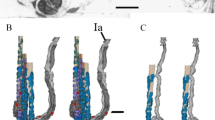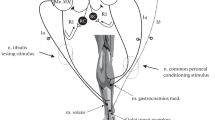Abstract
Responses of muscle spindles of tenotomized and hypertrophied muscles to stretching and vibration were investigated. During constant stretching of the muscles with a load of 100 g the spontaneous activity of the primary endings in the control muscle was 17±1.5 spikes/sec, in the hypertrophied muscle it was unchanged, and after tenotomy it was increased to 26±1.5 spikes/sec. The discharge frequency of the secondary endings was unchanged under these circumstances. Responses of primary and secondary endings of spindles of the tenotomized muscle during the dynamic and static phases of stretching were higher in frequency than responses of spindles of normal muscles. The discharge frequency of the primary endings in the hypertrophied muscle also was increased during both phases of stretching. Responses of secondary endings of the spindles of the hypertrophied muscle were indistinguishable under these circumstances from responses of normal muscles. Primary endings of spindles of tenotomized and hypertrophied muscles, just as normally, reproduced frequencies of vibration stimulation up to 2000 Hz, but some increase in the discharge frequency was observed in the secondary endings at this time.
Similar content being viewed by others
Literature cited
R. S. Arutyunyan, "Responses of the muscle spindles of fast and slow muscles to stretching," Fiziol. Zh. SSSR,59, 753 (1973).
R. S. Arutyunyan, "The effect of vibration on muscle receptors of fast and slow muscles," Fiziol. Zh. SSSR,57, 1298 (1971).
A. Bessou and Y. Laporte, "Responses from primary and secondary endings of the same neuromuscular spindle of tenuissimus muscle of the cat," in: Symposium on Muscle Receptors (ed. by D. Barker), Hong Kong (1962), pp. 105–109.
B. Bianconi and J. P. Van der Meulen, "The response to vibration of the end organ of mammalian muscle spindle," J. Neurophysiol.,26, 177 (1963).
A. Buller and D. Lewis, "Some observation on the effect of tenotomy in the rabbit," J. Physiol. (London),178, 326 (1965).
S. Cooper, "The response of primary and secondary endings of muscle spindles and their functional significance," Quart. J. Exp. Physiol.,46, 389 (1961).
S. Cooper and M. Gladden, "Elastic fibers and reticulum of mammalian muscle spindle with intact motor innervation during applied stretch," Quart. J. Exp. Physiol.,59, 367 (1974).
D. Denny-Brown, "Experimental studies pertaining to hypertrophy, regeneration, and degeneration," in: Proceedings of Association for Research in Nervous and Mental Disease (ed. by R. D. Adams, L. Easton, and A. Shy), London-New York (1960), pp. 147–196.
G. Eklund and K. Hagbarth, "Normal variability of tonic vibration reflex in man," Exp. Neurol.,16, 80 (1966).
J. Estavillo, H. Yellin, and Y. Sasaki, "Observation on expected decrease in proprioceptive discharge and purported advent of non-proprioceptive activity from the chronically tenotomized muscle," Brain Res.,63, 75 (1973).
R. Granit and H. D. Henatsch, "Gamma control of dynamic properties of muscle spindle," J. Neurophysiol.,19, 356 (1956).
R. Harvey and P. Matthews, "The response of deefferented muscle spindle ending in the cat soleus to slow extention of the muscle," J. Physiol. (London),157, 270 (1961).
P. Hník, R. Beránek, L. Vyklický, and J. Zelená, "Sensory outflow from chronically tenotomized muscle," Physiol. Bohemoslov.,12, 23 (1963).
P. Hník and M. Lessler, "The enhanced response to stretch of tenotomized gastrocnemius of the rat," Brain Res.,33, 377 (1971).
P. Hník and M. Lessler, "Alteration in spindle activity during long-term tenotomy in the rat gastrocnemius muscle," Exp. Neurol.,40, 232 (1973).
C. Hunt, "Relation of function to diameter in efferent fibers of muscle nerves," J. Gen. Physiol.,38, 117 (1954).
B. Katz, "Action potential from sensory nerve endings," J. Physiol. (London),111, 248 (1950).
W. Kozak and R. Westerman, "Plastic changes of spinal monosynaptic response from tenotomized muscle in cat," Nature,189, 753 (1961).
S. Kuffler, C. Hunt, and J. Quilliam, "Function of medullated small nerve fibers in mammalian ventral root," J. Neurophysiol.,14, 29 (1951).
E. Mackova and P. Hnik, "Compensatory muscle hypertrophy in rat induced by tenotomy of synergistic muscle," Experientia,27, 1039 (1971).
E. Mackova and P. Hnik, "Time course of compensatory hypertrophy of slow and fast rat muscle in relation to age," Physiol. Bohemoslov.,21, 9 (1972).
E. Mackova and P. Hnik, "Compensatory muscle hypertrophy induced by tenotomy of synergists is not true working hypertrophy," Physiol. Bohemoslov.,22, 43 (1973).
A. Maier, E. Eldred, and V. Edgerton "The effect on spindle of muscle atrophy and hypertrophy," Exp. Neurol.,37, 100 (1972).
B. Matthews, "Nerve endings in mammalian muscle," J. Physiol. (London),78, 133 (1933).
P. Matthews, "Muscle spindles and their motor control," Physiol. Rev.,44, 219 (1964).
P. Matthews, "Vibration and stretch reflex," in: Myotatic, Kinaesthetic and Vestibular Mechanisms (ed. by A. V. S. De Reuck and J. Knight), Ciba Symposium, London (1966), pp. 40–50.
R. McMinn and G. Vrbova, "The effect of tenotomy on the structure of fast and slow muscle in rabbits," Quart. J. Exp. Physiol.,49, 124 (1964).
P. Merton, "Slow conducting muscle spindle afferents," Acta Physiol. Scand.,29, 87 (1964).
G. Shepherd and D. Ottoson, "Response of isolated muscle spindle to different rates of stretching," Cold Spring Harbor Symp. Quant. Biol.,30, 95 (1965).
G. Shepherd and D. Ottoson, "Receptor potentials and impulse generation in the isolated spindle during controlled extension," Cold Spring Harbor Symp. Quant. Biol.,30, 105 (1965).
Additional information
I. M. Sechenov Institute of Evolutionary Physiology and Biochemistry, Academy of Sciences of the USSR, Leningrad. Translated from Neirofiziologiya, Vol. 8, No. 3, pp. 311–317, September, 1976.
Rights and permissions
About this article
Cite this article
Arutyunyan, R.S. Responses of muscle spindles of tenotomized and hypertrophied muscles to stretching and vibration. Neurophysiology 8, 240–245 (1976). https://doi.org/10.1007/BF01064623
Received:
Issue Date:
DOI: https://doi.org/10.1007/BF01064623




